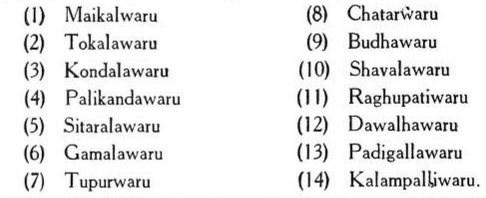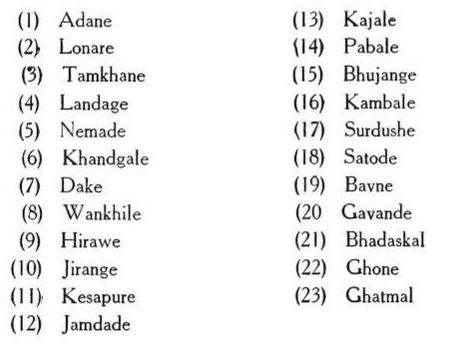Bhoi-Gunlodu: Deccan
Contents |
Bhoi-Gunlodu
This article is an extract from THE CASTES AND TRIBES OF H. E. H. THE NIZAM'S DOMINIONS BY SYED SIRAJ UL HASSAN Of Merton College, Oxford, Trinity College, Dublin, and Middle Temple, London. One of the Judges of H. E. H. the Nizam's High Court of Judicature : Lately Director of Public Instruction. BOMBAY THE TlMES PRESS 1920 Indpaedia is an archive. It neither agrees nor disagrees |
The Gunlodu, also called Nilbandhu, or the dwellers on the river bank, are mostly found in parts of the country where great rivers abound. Thus, they are found in the Nizamabad, Adilabad and Karimnagar Districts. They eat with the Bestas but do not intermarry with them. Their exogamous sections are as follows : —
Origin
The Nilbandhus give a singular account of their origin. The story runs thus : — There was one Narumani, who had a son by his mistress. Immediately on his birth the boy was exposed, by his mother, on the seashore and when full grown was disowned by his father, but commanded to subsist by fishing in the sea : since his profession bound him to the sea-shore, his descendants have been designated ' Nil-bandhus ' (neel, water, and bhandu, bank), or those who live on river banks. The legend suggests that the Nilbandhus may be illegitimate descendants of the Bestas, the great Telugu fishing caste. Their customs and usages are the same as those of the Bestas and need no separate description.
Maratha Bhois
Origin
The Maratha Bhois, as their name denotes, constitute the numerous members of the fishing* caste of the Marathawada country, which includes all the Districts of the Aurangabad Subah and the
Bidar and Usmanabad Districts of the Gulbarga Subah. In physical features and customs they differ markedly from the Telugu Bhois. They are divided into two endogamous groups — the Maratha proper and the Machinde — who eat together but do not intermarry. The Mciratha proper may be an off-shoot from the Maratha Kunbis, whom they closely resemble and from whom they are probably separated by having taken to the degraded occupation of fishing and litter bearing. Tiie Machinde Bhois claim to be descended from Machindranath, the chief disciple of Gorakhnath, the famous founder of the sect of Kan- phate Jogis. This, however, gives no clue to the real origin of the sub-caste. •
Internal , Structure
The Maratha Bhois have a number of exogamous sections, consisting of family surnames, many of which are common to this caste and the Maratha Kunbis. The following are some of the commonest of them : —
Marriage
Marriages within the surname are prohibited. A man cannot marry the daughter of his maternal aunt or of his sister, though he may marry that of his maternal uncle. He rarely marries his paternal aunt's daughter, although such marriages are not pro- hibited by any tribal usage. Two sisters may be married to the same husband, or to two brothers, provided the elder sister is married to the elder brother and the younger sister to the younger.
The Maratha Bhois marry their daughters Doth as infants, and as adults between the ages of' eight and twenty, and their sons between twelve and twenty-five. Sexual intercourse before marriage is tolerated, but a girl taken in adultery is punished with a small fine. If she becomes pregnant before marriage her paramour is called upon to marry her, but in case he declines, she loses caste. Polygamy is permitted. In theory, there is no limit to the number of wives a man may have and it is not uncommon to find a man having more than one wife
The father of the boy, as a rule, takes the initiative towards the settlement of a marriage. At the betrothal, or kunku lavane, the girl is presented with a sari and the caste panch receiye, by right, Rs2 from the boy's father for khusali or drinking. The Devak, or marriage deity, is represented by twigs of the mango, saundad (Prosopis spicigera) and apta (Bauhinia racemosa), which are tied, with an axe and a wooden pestle, to the milk post (muhurta medha) of the marriage booth. Previous to the marriage, Virs (ancestral spirits) and the goddess Bhavani of Tulja- pur are propitiated by the sacrifice of a goat. The marriage procession is usually made on horseback, but occasionally on a bullock. Pam- grahana, or the gift of the bride to the bridegroom, forms the essen- tial portion of the ceremony. In other respects it resembles that of the Maratha caste. A widow may marry again. Divorce is per- mitted on the ground of the wife's adultery, or if the couple cannot live in harmony.
Religion
Ancestral worship is in full force and the souls of the departed are propitiated every Saturday by the elderly member of the family ; the souls of adults are called Virs, those of children Munjas and of females Manvi. On the wedding day goats are sacrificed in honour of these spirits. The members of the caste are very scrupulous in the worship of these spirits, for it is firmly believed that if they neglect this worship they will never live in peace and happiness. Muhammadan pirs are also duly honoured with animal sacrifices. Brahmans are employed for religious and ceremonial purposes. The dead are burned, but occasionally buried. Mourning is observed for 9 days, and on the 10th day Sradha is performed and the caste people are feasted. Sradha is also celebrated on the Pitra Amawasya)a day and on the Akshatritiya)a day.

